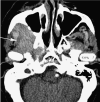CT-guided core needle biopsy of deep suprahyoid head and neck lesions in untreated patients
- PMID: 24070087
- PMCID: PMC3806013
- DOI: 10.1177/159101991301900315
CT-guided core needle biopsy of deep suprahyoid head and neck lesions in untreated patients
Abstract
This study aimed to evaluate the efficacy of CT-guided core needle biopsy (CNB) in the diagnosis of deep head and neck tumors in untreated patients. We retrospectively reviewed the records of ten consecutive CT-guided CNB procedures from ten patients without a related history from March 2004 to February 2012. The surgical results, treatment response and clinical follow-up were used as the diagnostic standards. All specimens were considered adequate. Nine out of ten cases matched the final diagnosis. Biopsy failed to diagnose the infratemporal meningioma en plaque in a particular case. Three cases were carcinomas. No complication was encountered. CT-guided core needle biopsy is an efficient and safe technique for histological diagnosis of skull base lesions in patients without a related history. This technique can offer a definite tissue diagnosis and avoid unnecessary surgical interventions for such patients.
Figures


References
-
- Nyquist GG, Tom WD, Mui S. Automatic core needle biopsy: a diagnostic option for head and neck masses. Arch Otolaryngol Head Neck Surg. 134;2:184–189. doi: 10.1001/archoto.2007.39. - PubMed
-
- Pfeiffer J, Kayser G, Technau-Ihling K, et al. Ultrasound-guided core-needle biopsy in the diagnosis of head and neck masses: indications, technique, and results. Head Neck. 2007;29(11):1033–1040. - PubMed
-
- Gupta S, Henningsen JA, Wallace MJ, et al. Percutaneous biopsy of head and neck lesions with CT guidance: various approaches and relevant anatomic and technical considerations. Radiographics. 2007;27(2):371–390. - PubMed
-
- Howlett DC, Mercer J, Williams MD. Same day diagnosis of neck lumps using ultrasound-guided fine-needle core biopsy. Br J Oral Maxillofac Surg. 2008;46(1):64–65. Epub 2007/06/05. - PubMed
MeSH terms
LinkOut - more resources
Full Text Sources
Other Literature Sources
Medical
Research Materials

